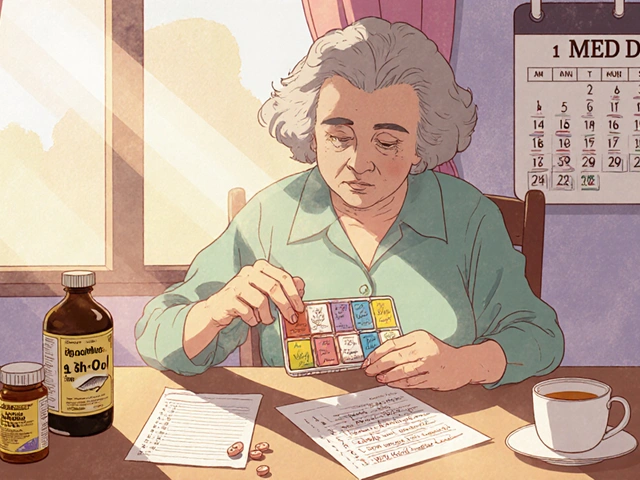Modafinil vs Alternatives Comparison Tool
Filter Options
Comparison Table
| Drug | Mechanism | Typical Onset | Duration | Prescription? | Major Side-effects |
|---|
Looking for a boost in wakefulness but unsure whether Modafinil alternatives are worth the switch? You’re not alone. People juggling night shifts, study marathons, or chronic fatigue often wonder which pill will keep them alert without nasty crashes. This guide walks through the most popular substitutes, compares how they stack up on key factors, and helps you decide what fits your lifestyle.
What is Modafinil (Vilafinil)?
Modafinil is a prescription wake‑promoting agent initially approved for narcolepsy, shift‑work sleep disorder, and obstructive sleep apnea‑related daytime sleepiness. Marketed under brand names like Provigil, it works by subtly nudging several brain pathways-especially dopamine, norepinephrine, and orexin-toward heightened alertness while preserving normal sleep patterns.
Typical doses range from 100mg to 200mg taken once daily in the morning. Users report a clean, jitter‑free lift that can last 10‑12hours, making it a favorite among professionals and students seeking sustained focus.
How Modafinil Works
The exact mechanism isn’t fully mapped, but research shows Modafinil blocks dopamine reuptake, increases histamine release, and stimulates the hypothalamic orexin system. This multi‑target approach explains why it feels less “wired” than classic stimulants.
Because it doesn’t flood the brain with excess dopamine, the risk of severe dependence is lower, though tolerance can still develop with daily use.
Why Look for Alternatives?
Even a well‑tolerated drug has limits. Some users chase a quicker onset, a longer duration, or a non‑prescription option. Others avoid Modafinil due to side‑effects like headaches, reduced appetite, or rare skin reactions. Insurance coverage, cost, and local regulations also push people toward other choices.
Below are the most talked‑about alternatives, each with its own strengths and trade‑offs.
Armodafinil (Nuvigil)
Armodafinil is essentially the R‑enantiomer of Modafinil-think of it as the “right‑handed” version of the molecule. It was introduced as Nuvigil and is marketed for the same sleep‑disorder indications.
- Mechanism: Same pathways as Modafinil but with a slightly longer half‑life (≈15hours).
- Onset: 30‑60minutes.
- Duration: Up to 14hours, often reported as smoother toward the evening.
- Side‑effects: Similar to Modafinil-headache, nausea-but some users claim fewer mood swings.
Adrafinil
Adrafinil is a pro‑drug: once ingested, the liver converts it into Modafinil. It’s sold over the counter in several countries, which makes it attractive for those without a prescription.
- Mechanism: Becomes Modafinil in the body, so effects mirror its parent drug.
- Onset: 60‑90minutes (slower due to conversion).
- Duration: 8‑10hours.
- Side‑effects: Liver strain with chronic high‑dose use; routine liver‑function tests recommended.

Pitolisant (Wakix)
Pitolisant is a histamine H3 receptor antagonist, approved in the EU for narcolepsy with or without cataplexy. It works by increasing histamine release, a different route than dopamine‑focused agents.
- Mechanism: Boosts brain histamine, promoting wakefulness.
- Onset: 30‑45minutes.
- Duration: 12‑14hours.
- Side‑effects: Insomnia, nausea, occasional anxiety.
Caffeine
Caffeine is the world’s most widely used stimulant, found in coffee, tea, energy drinks, and pills. While not a prescription drug, it offers a quick, familiar lift.
- Mechanism: Blocks adenosine receptors, reducing sleep pressure.
- Onset: 5‑10minutes.
- Duration: 3‑5hours.
- Side‑effects: Jitters, heart‑rate spikes, rebound fatigue.
Amphetamine (d‑amphetamine)
Amphetamine classes include Adderall and Dexedrine, commonly prescribed for ADHD and sometimes off‑label for wakefulness. They act by releasing large amounts of dopamine and norepinephrine.
- Mechanism: Massive catecholamine release.
- Onset: 15‑30minutes.
- Duration: 4‑8hours (short‑acting) or 10‑12hours (extended‑release).
- Side‑effects: Appetite suppression, anxiety, potential for dependence.
Methylphenidate (Ritalin, Concerta)
Methylphenidate works similarly to amphetamine but with a milder dopamine surge. It’s used for ADHD and narcolepsy, offering a balanced wake‑promoting effect.
- Mechanism: Blocks dopamine reuptake.
- Onset: 20‑30minutes.
- Duration: 3‑4hours (immediate‑release) or 8‑12hours (extended‑release).
- Side‑effects: Insomnia, stomach upset, occasional mood swings.
Side‑by‑Side Comparison
| Drug | Mechanism | Typical Onset | Duration | Prescription? | Major Side‑effects |
|---|---|---|---|---|---|
| Modafinil | Dopamine reuptake inhibition + orexin activation | 30‑60min | 10‑12hr | Yes | Headache, reduced appetite, rare rash |
| Armodafinil | Same as Modafinil (R‑enantiomer) | 30‑60min | 12‑14hr | Yes | Similar to Modafinil, possibly milder mood impact |
| Adrafinil | Pro‑drug → Modafinil in liver | 60‑90min | 8‑10hr | No (OTC in many regions) | Liver enzyme elevation, nausea |
| Pitolisant | Histamine H3 antagonism | 30‑45min | 12‑14hr | Yes (EU) | Insomnia, nausea, anxiety |
| Caffeine | Adenosine receptor blockade | 5‑10min | 3‑5hr | No | Jitters, heart‑rate rise, crash |
| Amphetamine | Dopamine & norepinephrine release | 15‑30min | 4‑12hr | Yes | Appetite loss, anxiety, dependence risk |
| Methylphenidate | Dopamine reuptake inhibition | 20‑30min | 3‑12hr | Yes | Insomnia, stomach upset, mood swings |

How to Choose the Right Wake‑Promoting Agent
Think of the decision like picking a work shift: you need to match the start time, length, and intensity to your schedule.
- Onset speed: If you need a boost in the next 10 minutes, caffeine or amphetamine wins.
- Duration needed: For all‑day coverage, armodafinil or pitolisant are top picks.
- Prescription access: In regions where Modafinil is tightly controlled, adrafinil offers a legal OTC bridge-just watch liver labs.
- Side‑effect tolerance: Users sensitive to anxiety may steer clear of amphetamines and opt for the smoother Modafinil family.
- Cost considerations: Generic Modafinil and Adrafinil tend to be cheaper than brand‑named armodafinil or pitolisant.
Combine these criteria with personal health history-especially heart or liver conditions-and you’ll land on the safest, most effective choice.
Safety, Interactions, and Legal Landscape
All wake‑promoting drugs can interact with other medications. Modafinil, for example, can lower the efficacy of hormonal contraceptives and increase blood‑level of certain antidepressants. Amphetamines raise blood pressure, so they’re risky for people with hypertension.
Legal status varies. In South Africa, Modafinil and armodafinil are Schedule‑4 prescription medicines. Adrafinil is not scheduled, but importing large quantities can raise customs flags. Pitolisant holds a prescription‑only status in the EU but is still unapproved in many other markets.
Never share pills, and always start with the lowest effective dose. If you notice persistent headaches, skin rashes, or mood changes, pause the drug and consult a clinician.
Practical Tips for Using Wake‑Promoting Drugs
- Take the dose early in the day-most agents can interfere with nighttime sleep if taken after 2pm.
- Stay hydrated; many users report dry mouth, especially with Modafinil and amphetamines.
- Pair with good sleep hygiene: blackout curtains, limited screen time, and a regular bedtime improve overall effectiveness.
- If you’re cycling (e.g., using Modafinil 5days on, 2days off), monitor for rebound fatigue on off days.
- Track side‑effects in a simple journal; patterns emerge faster than you think.
Bottom Line
There’s no one‑size‑fits‑all answer. Modafinil remains the gold standard for a clean, long‑lasting boost with moderate side‑effects, but alternatives like armodafinil, adrafinil, pitolisant, or even caffeine can fill specific gaps-whether you need a faster kick, a non‑prescription route, or a different mechanism entirely. Weigh onset, duration, legal access, and personal tolerance, then test responsibly.
Frequently Asked Questions
Is Modafinil safe for long‑term use?
Clinical studies up to two years show Modafinil is generally well‑tolerated, but routine check‑ups are advised to monitor blood pressure and liver function, especially if you have pre‑existing conditions.
Can I buy Modafinil without a prescription?
In most countries-including South Africa-Modafinil is prescription‑only. Online pharmacies may claim to sell it OTC, but quality and legality are uncertain. Adrafinil remains the legal OTC alternative in many regions.
How does armodafinil differ from Modafinil?
Armodafinil is the R‑enantiomer of Modafinil, offering a slightly longer half‑life and potentially smoother evening wear‑off. Doses are usually half of Modafinil (150mg vs 200mg), but efficacy is comparable.
Is caffeine a good substitute for Modafinil?
Caffeine works fast but lasts only a few hours and can cause jitters or a crash. If you need all‑day focus without sleep disruption, Modafinil‑type drugs are more reliable.
What are the risks of combining Modafinil with other stimulants?
Mixing two stimulants can spike blood pressure, heart rate, and anxiety. Doctors usually advise against stacking Modafinil with amphetamines, methylphenidate, or high‑caffeine doses.







cris wasala
6 October, 2025 14:56 PMGreat overview thanks for sharing
Tyler Johnson
8 October, 2025 16:56 PMWhen you look at wake‑promoting pharmacology the first consideration is the intended effect.
Onset speed determines whether a substance fits a sudden shift‑work schedule or a gradual study marathon.
Duration defines if you need a short burst for a meeting or all‑day coverage for a long flight.
Prescription status often dictates availability and cost in a given country.
The safety profile is crucial, especially for people with cardiovascular or hepatic concerns.
Modafinil and its R‑enantiomer offer a clean lift with relatively low anxiety compared to classic stimulants.
Amphetamines, while rapid, bring a higher risk of dependence and blood‑pressure spikes.
Caffeine provides the fastest kick but the crash can undermine productivity after a few hours.
Pitolisant’s histamine pathway gives a unique option for those who react poorly to dopamine‑based drugs.
Adrafinil bypasses the prescription barrier but demands regular liver‑function monitoring.
Cost differences can swing decisions, with generic Modafinil often cheaper than brand‑name armodafinil.
Tolerability varies individually; some users report headaches with Modafinil while others feel nausea from Pitolisant.
Timing of the dose is a practical tip: taking any agent after 2 pm can jeopardize night sleep.
Combining two stimulants usually amplifies side‑effects and should be avoided unless medically supervised.
Ultimately, matching the pharmacokinetic profile to personal lifestyle yields the safest and most effective outcome.
Annie Thompson
10 October, 2025 18:56 PMReading through that list feels like a rollercoaster of hopes and doubts.
The promise of a clean boost can turn into anxiety when side‑effects loom.
I have seen friends chase the quick buzz of amphetamines only to end up exhausted later.
The liver warnings on Adrafinil whisper a hidden danger that many ignore.
Even the gentle whisper of caffeine can become a frantic heartbeat for sensitive souls.
The idea of a prescription‑only barrier feels like a gatekeeper judging our need for focus.
Yet the fear of dependence gnaws at anyone considering Modafinil.
The balance between wakefulness and the crash is a fragile dance.
When the night shift stretches on, every pill becomes a gamble.
In the end the emotional toll often outweighs the fleeting clarity.
Parth Gohil
12 October, 2025 20:56 PMFrom a pharmacokinetic standpoint the Tmax of modafinil hovers around 2‑3 hours, which aligns nicely with a typical 9‑to‑5 workday.
Contrast that with the rapid 15‑minute Tmax of caffeine – great for a quick jolt but not ideal for sustained alertness.
For those monitoring hepatic metabolism, the CYP3A4 pathway is the primary route for both modafinil and armodafinil, meaning potential drug‑drug interactions should be screened.
Adrafinil’s pro‑drug nature adds a first‑pass conversion step, extending its latency but also imposing a hepatic load.
Ultimately the choice boils down to a trade‑off between onset latency, duration, and side‑effect profile.
VAISHAKH Chandran
14 October, 2025 22:56 PMInteresting but missing the nuance of cultural access and the economic realities that shape drug choice.
Pat Merrill
17 October, 2025 00:56 AMAh the perpetual quest for the perfect focus pill – it’s almost philosophical, isn’t it?
We chase synthetic clarity while nature offers a cup of coffee and a good night’s sleep.
Of course the allure of a “clean” boost is tempting, but the irony is that none of these compounds are truly without a shadow.
One could argue that the best “nootropic” is simply disciplined routine, but that’s far less marketable.
So we keep buying pills, hoping the next one will finally balance productivity with peace of mind.
Vicki Roth
19 October, 2025 02:56 AMWhile the philosophical angle is amusing, the practical takeaway is clear: pick a drug that matches your schedule and health profile.
Vishal Bhosale
21 October, 2025 04:56 AMThese tables are just marketing fluff – real life effects vary way more.
Garima Gauttam
23 October, 2025 06:56 AMMarketing fluff? Maybe, but the data still shows measurable differences in half‑life and receptor activity.
Georgia Nightingale
25 October, 2025 08:56 AMThe drama of choosing a wake‑promoting agent is akin to selecting a character for a stage play – each brings its own quirks, timing, and audience reaction.
First, the protagonist: Modafinil, the reliable lead with a steady arc, delivering a performance that lasts for hours without stealing the spotlight.
Then there’s the understudy, Armodafinil, who steps in with a slightly longer encore, sometimes smoother in the dusk.
The wildcard, Adrafinil, enters without a formal contract, offering a surprise cameo that demands a backstage health check.
Pitolisant plays the avant‑garde role, breaking the fourth wall of neurotransmission with histamine flair.
Caffeine, the comic relief, bursts onto the scene in seconds, only to exit with a cringeworthy slump.
Amphetamines are the intense method actors, delivering raw energy at the risk of blowing the set.
Methylphenidate takes the nuanced supporting role, balancing focus with occasional emotional swings.
The director’s note: timing is everything – a mistimed cue can turn a triumph into a disaster.
Costumes matter too; generic scripts save money, while brand names charge for the polish.
Audience tolerance varies – some love the high‑octane thrill, others prefer a gentle tide.
Rehearsals (dose trials) should be done in a controlled environment, preferably with a professional coach (doctor).
Remember, the finale is sleep; no performance should jeopardize the curtain call.
Thus, casting the right agent for your script ensures a standing ovation rather than a chaotic improv.
Chris Kivel
27 October, 2025 10:56 AMI appreciate the theatrical analogy – it really puts the pharmacology into perspective.
sonia sodano
29 October, 2025 12:56 PMHonestly, most people just need coffee and a decent bedtime.
Praveen Kumar BK
31 October, 2025 14:56 PMWhile simplicity has its charm, it’s morally irresponsible to downplay the seriousness of prescription stimulants.
Each tablet carries a cascade of neurochemical consequences that cannot be ignored for the sake of convenience.
We owe it to ourselves and to public health to treat these substances with the respect they deserve.
Otherwise we risk normalizing misuse and eroding the trust between patients and clinicians.
Viji Sulochana
2 November, 2025 16:56 PMJust a quick note – “downplay” should be “down‑play”, and “cascade” is a bit dramatic for a biochemical pathway.
Stephen Nelson
4 November, 2025 18:56 PMWhen you peel back the layers of the nootropic market you realize it’s a glittering illusion of productivity – the real work never happens without discipline.
Fredric Chia
6 November, 2025 20:56 PMThe assertion lacks empirical support; disciplined behavior remains the primary determinant of performance.
Hope Reader
8 November, 2025 22:56 PMNice point, but I think a little caffeine never hurt anyone :)
Marry coral
11 November, 2025 00:56 AMSure, but don’t let that excuse you from making better life choices.